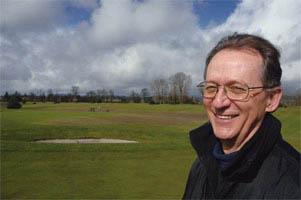Tom Cook pioneered the turf program at Oregon State University
During a 30-plus-year career at Oregon State University, Tom Cook was doing more than running one of the country's top turfgrass programs. He also viewed his job as part-time matchmaker.
 "Looking back now, it's pretty funny. I thought what I did was run a dating service, matching personalities with golf courses," said Cook. "You have to get to know the students and their style and match them with the right superintendents so they could progress in the industry."
"Looking back now, it's pretty funny. I thought what I did was run a dating service, matching personalities with golf courses," said Cook. "You have to get to know the students and their style and match them with the right superintendents so they could progress in the industry."
Cook, 67, took over the Oregon State program in 1977 when he was just 27 years old. During the next 31 years, until he retired in 2008, more than 300 students went through the program that Cook ran mostly as a one-man show.
"I couldn't seem to accumulate enough funds to hire anyone until about six years before I retired," he said. "But I had lots of energy."
It wasn't until 2001, when he hired Brian McDonald as a research assistant that he had paid help.
"It was like the Great Pyramids: Nobody knows how he built it. Before I got there it was just him. What Tom managed to do by himself is a mystery," said McDonald, a former student under Cook who graduated from Oregon State in 2000 after a career as an accountant.
"The university never game him a dime more than his salary. When he started the turf farm, he was bringing his own lawn mower out there. That's how far it has come."
Of those 300 or so students, about 200 went into the golf business and 150 or so eventually became superintendents, Cook said.
His influence on the turf industry in the Pacific Northwest still reverberates today, said Tod Blankenship, CGCS, a former research assistant at OSU under Cook's successor, Rob Golembiewski, Ph.D.
"Tom is a legend here in the Northwest," said Blankenship, now a parks director for the city of Wilsonville, Oregon.
"You go to any golf course in the Northwest, and there's a pretty good chance that there's a Beaver running the show, or an assistant or someone in the ranks. It all starts with Tom. There really wasn't a program here before Tom."
Cook was unique among his peers across the country in that he never earned a doctorate degree, and thus never had a research appointment. That did nothing to diminish his work, or the effects of his extension work across the state. He spent about 75 percent of his time on the job teaching. He was the turfgrass extension agent for the entire state and still managed to do tons of research.
"A lot of his stuff didn't get published, but he had so much research that he'd done over the years," Blankenship said. "I think that foundation alone, the amount of research that went on that no one knows about, it laid the way for what they're doing (at Oregon State) now."
"It all goes back to Tom. There really wasn't a program before Tom."
It was like the Great Pyramids: Nobody knows how he built it. . . . What Tom managed to do by himself is a mystery."
In the years since he left Oregon State, Cook has drifted away from golf somewhat and has developed a fondness for lawns and landscaping. He still lives in Corvallis with wife Marilyn in the house they've owned since 1984, where he has grown a yard that, as McDonald said, looks like it belongs on the cover of a magazine.
Shortly after he retired, Cook co-authored a book with Ann Marie VanDerZanden entitled Sustainable Landscape Management: Design, Construction and Maintenance (Wiley, 2010). Soon after, he went off the grid for a while, but has recently rekindled his interest in lawn and landscape management.
"I went into a fog for a while, but I'm kicking around an idea for another book," he said.
"Lawns are fascinating. They are a cornucopia of plants, and grass is only one of them."
Throughout the duration of his career, Cook encountered changes in management practices, seed varieties, equipment and chemistries used to manage turfgrass pests.
"Things are different here in the Northwest than everywhere else. People had to make their own knowledge base," he said. "To keep up, I read everything I could get my hands on. And we had a lot of projects going on at the farm.
"For me, another pipeline was my former students. I spent a lot of time visiting golf courses and talking to superintendents. I learned from them. They're pretty innovative and creative and they would share with me and I would learn from their successes, or failures."
Cook loved turf and he loved his students.
"His favorite thing to do is mow," McDonald said. "Ii remember when I got to Oregon State as a student and would volunteer at the farm, and he would come out every Friday afternoon and mow. I thought we were failing because he was out there mowing, but it was just his way of keeping in touch with the turf and his down time where he could look at the turf and be by himself."


2 Comments
Recommended Comments